So, you have the dream of taking on a big transatlantic voyage and sailing across the Atlantic Ocean? There are certain bucket list items that all sailors want to tick off the list, and transatlantic voyages are right up there with the best of them. This vast expanse of water, one of the world’s five great oceans, is home to a million stories of courage, fortitude, drama, and adventure and has been a proving ground for sailors since immemorial. Transatlantic sailing is a genuine challenge, a unique life experience, and a few weeks of your life you will value forever.
Here, Rubicon 3, the undisputed offshore and adventure sailing experts and author of many ocean sailing articles in the likes of Yachting World, give their overview of how to make an Atlantic crossing, when to do it, the different routes, what to expect, how to know if you’re ready and how to prepare.
In this article, we cover:
- Choosing a Transatlantic Route
- Best Time for a Transatlantic Crossing
- Weather and Conditions on a Transatlantic Voyage
- Daily Life on a Transatlantic Sail
- The Ideal Boat for Transatlantic Sailing
- Essential Safety Equipment
- Skill Requirements for Transatlantic Sailing
- How Long Does it Take To Sail Across the Atlantic Ocean
Which transatlantic route to take
Sailing from East to West
The most common route for those looking to sail across the Atlantic is from east to west, sailing west from the Canary Islands to the West Indies, notably St Lucia. Around 2100 miles, this route has the considerable advantage of being in the north-easterly trade winds. Formed by the heating of the earth at the equator, the trades in the northern hemisphere are a consistent and powerful wind from the northeast, meaning most crossings on this route are a downwind sail and with favorable ocean currents. The trade winds can come and go, and there is no certainty that you will be in them for the whole crossing. Once a year, the Atlantic Rally for Cruisers (ARC) is run on this route by the World Cruising Club (something which Rubicon 3 finds fun to take part in), starting in Las Palmas Gran Canaria and finishing in Rodney Bay St Lucia.
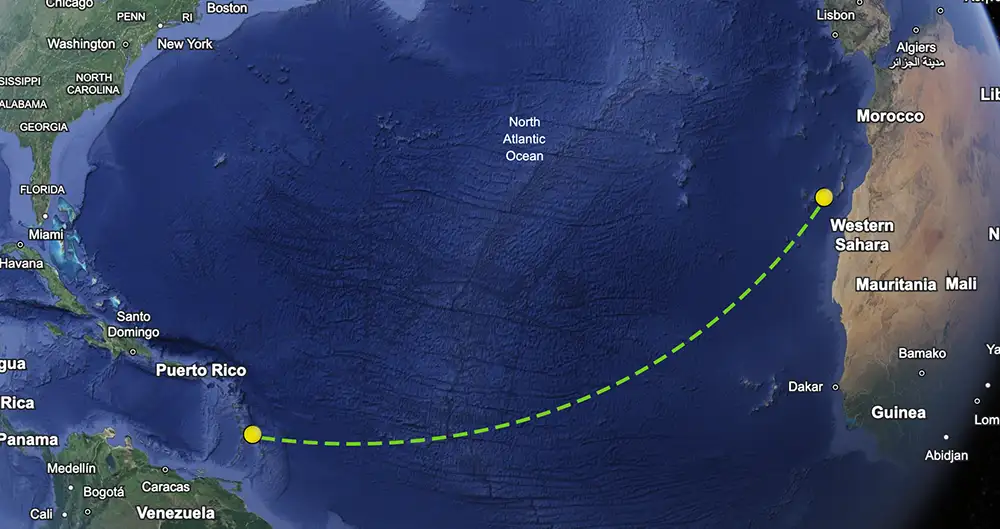
Sailing from West to East – the southern route
Once a year, you will see a large armada of yachts set sail from the West Indies once the Caribbean Season ends. This can be anytime from April through to late May. The Azores high, a large clockwise rotating mass of air, usually with a big wind hole right in the middle, means the yachts first have to sail north towards Bermuda, before turning east to pick up the prevailing winds that should be from the south west. It adds a lot of distance, with the first leg to Bermuda being around 1000 miles and then another 2000 miles to the Azores or Canary Islands. Rubicon 3 runs this route once a year but ramps up the excitement by making it a celestial navigation-only crossing that doesn’t use the GPS (full training given in the Caribbean first!)
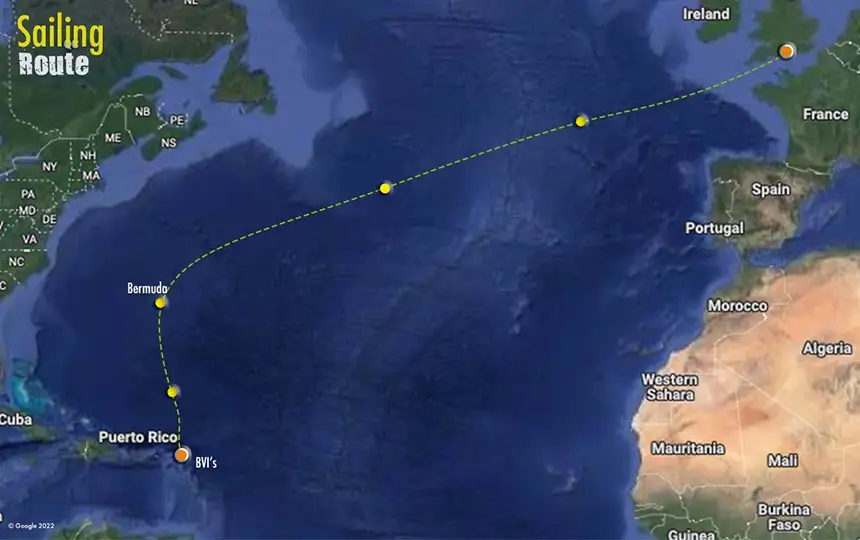
Sailing from West to East – the northern route
Now, you are off the beaten track and starting on what we would describe as the Ultimate Transatlantic voyage. The aim is to pick up the prevailing westerlies and be powered across the Atlantic by the powerful weather systems sweeping west to east. Our route starts in the glamour of Manhattan and New York City on the U.S. east coast before sailing north through Long Island Sound, up the east coast of Nova Scotia, and even further north to Newfoundland, by which time we are in iceberg fog and whale territory. Only then do we turn east for the 2000 miles to the United Kingdom. There is a reason it is the ultimate crossing and far beyond the capabilities of most yachts.
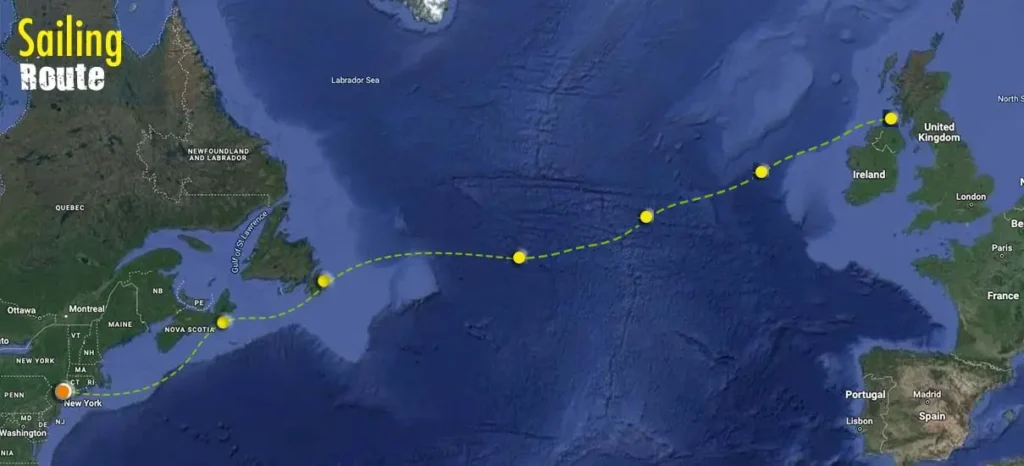
What time of year to make a transatlantic crossing
The time of year is set mainly by the hurricane season affecting the Caribbean and North America’s east coast. Hurricanes affect this area from June to November, making this a no-go time. This is why yachts sailing east to west from the Canary Islands usually do so between late November and January, ensuring they arrive at a reasonable time to enjoy the Caribbean season. Heading from west to east, one must leave before the hurricanes become a threat, so by late May at the latest. There is a sweet spot around early April through May when the major storms that can sweep the Atlantic are less likely, and weather conditions are warmer. This is when you’ll see yachts leave en masse from Antigua and the British Virgin Islands. Watch out for anyone sailing from west to east in January or February and ask why!
The weather and conditions to expect on a Transatlantic Voyage
Sailing across the Atlantic Ocean can mean a variety of weather, and this will vary significantly depending on the route taken, the time of year, and the current weather patterns. Here are some of the typical conditions sailors might encounter. In the Northern Hemisphere, sailors often utilize the northeast trade winds and associated ocean currents, while in the Southern Hemisphere, the southeast trade winds prevail. The equatorial region, known as the Doldrums, is notorious for lighter winds and calm seas interspersed with sudden and powerful squalls. From June to November, the Atlantic hurricane season risks tropical storms and hurricanes, particularly in the North Atlantic, necessitating vigilant weather monitoring and careful route planning.
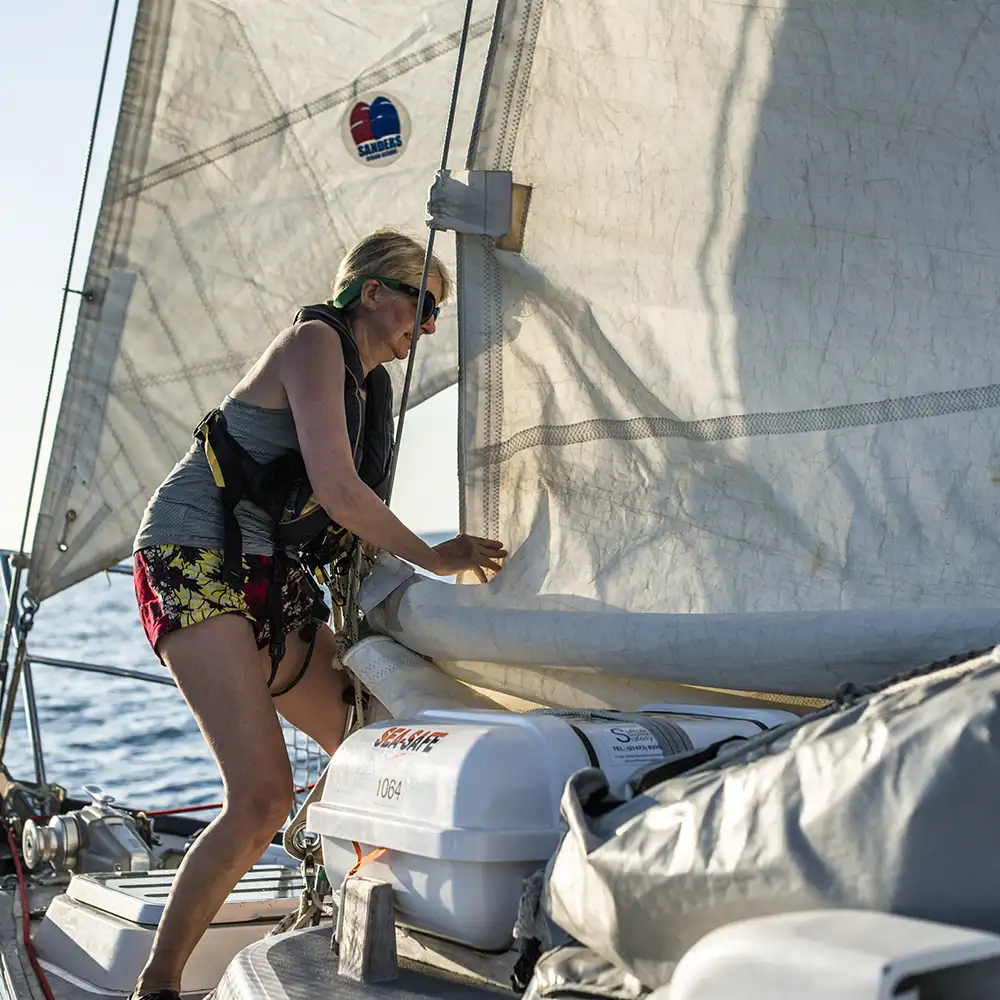
Sailors encounter more unpredictable weather in higher latitudes, including stronger winds, rougher seas, and colder temperatures. The Gulf Stream in the North Atlantic can significantly affect weather and sea conditions. Additionally, sailors must be prepared for squalls, thunderstorms, fog (especially in regions like the Grand Banks), and wide temperature variations, from hot and humid near the equator to cold in northern or southern routes. The sea state can vary from calm to very rough, influenced by storms and high winds, underscoring the importance of being well-prepared, equipped, and skilled in navigating diverse and often challenging conditions.
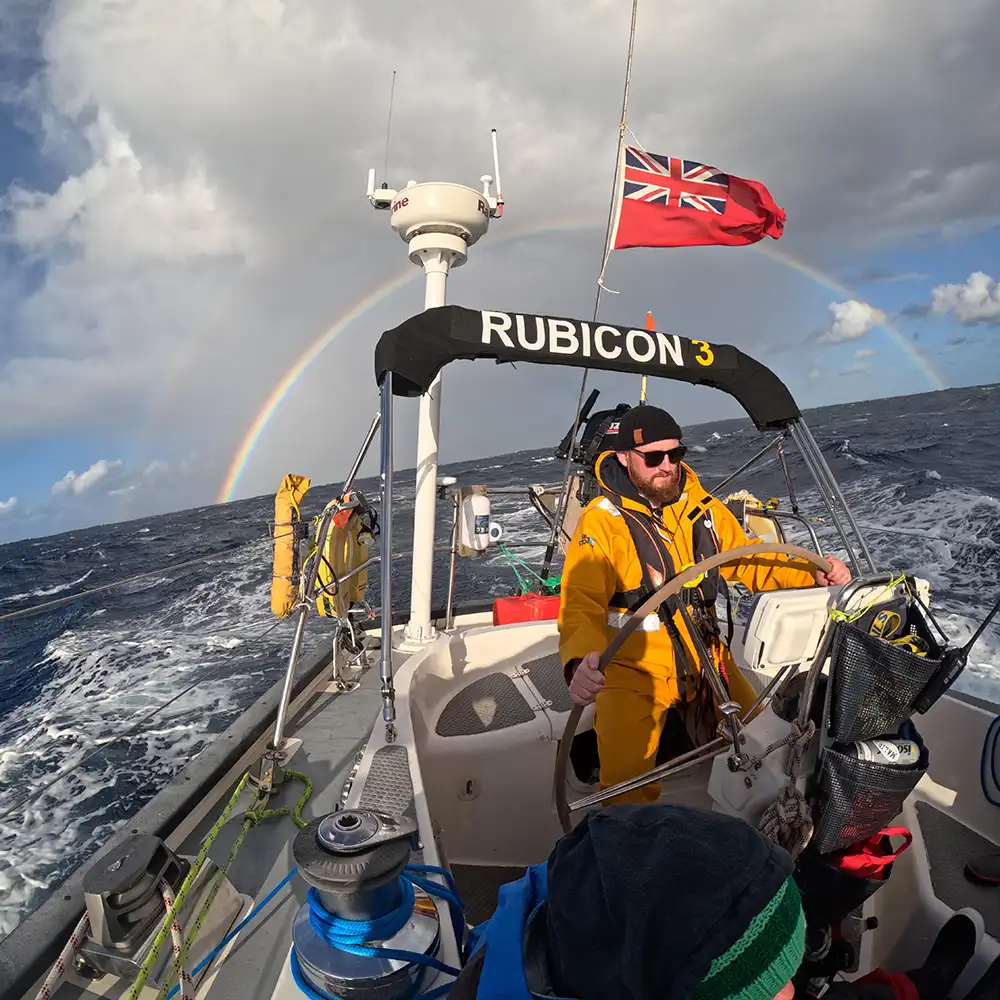
What can you expect sailing across the Atlantic Ocean?
Offshore sailing is a very different experience from coastal sailing. There is both less to do and more to do. Various activities and routines ensure the vessel’s smooth operation and safe navigation. However, there is also plenty of time for relaxation and bonding among the crew. This section explores the daily life at sea, focusing on onboard responsibilities, shifts, and leisure time.
Onboard Responsibilities and Shifts
Watchkeeping: One of the most critical responsibilities on a sailing vessel is watchkeeping. Crew members will typically be divided into watches and assigned specific hours to monitor the boat’s course, weather conditions, and potential hazards. This is a round-the-clock duty; each member must be vigilant during their watch. On a Rubicon 3 yacht, which has a slightly larger crew than on a leisure yacht, we will usually run a 3 hours on – 6 hours off routine, allowing you to stay fresh and well rested, as opposed to the more grueling four hours on – four hours off that is common on other yachts.
Another crucial aspect of watchkeeping is monitoring the weather forecast and visually looking to see what is coming. We try to avoid too much wind and too little wind (& indeed wind from the wrong direction!), meaning some good weather forecasting is essential. The satellite communication systems will receive the latest weather conditions regularly, while the radar will show us squalls’ strength, size, and distance.
If you are looking to gain your RYA Yachtmaster Ocean, all Atlantic Ocean crossings are qualifying passages. You must sign up as a Watch Leader, and you must have appropriate experience.
Navigation: Part of the routine for those on watch involves checking our position and updating the vessel’s course. It requires looking up our position on the GPS system, deducing it from celestial navigation, then plotting the position on the charts, adjusting the sails, and ensuring the boat is on the correct heading.
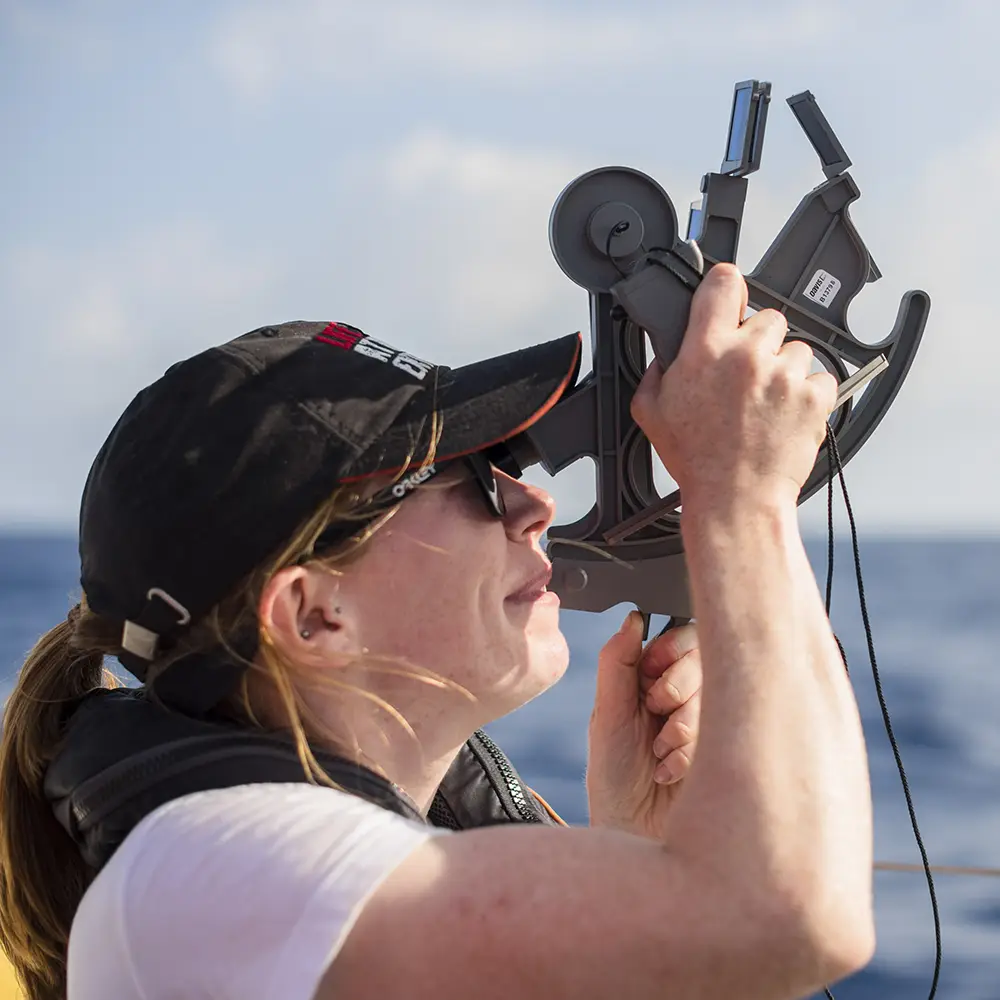
Maintenance and Cleaning: Daily checks and regular maintenance are also crucial for the safety of the vessel out on an Atlantic crossing. This includes checking the rigging, sails, bilges, pumps, and myriad other systems we rely on. Chafes of rope, sails, and fittings are particular areas to watch, as the constant movement and rolling out on the ocean can play havoc with even the most robust materials. We’ll make any necessary repairs as we go. Cleaning duties are also shared among the crew, ensuring that living spaces and communal areas remain hygienic and comfortable.
Meal Preparation: Cooking at sea is a fun and communal activity, with crew members taking turns to prepare meals. Given the limited space and resources, meals are usually simple but nutritious, designed to provide the energy needed for the demands of sailing.
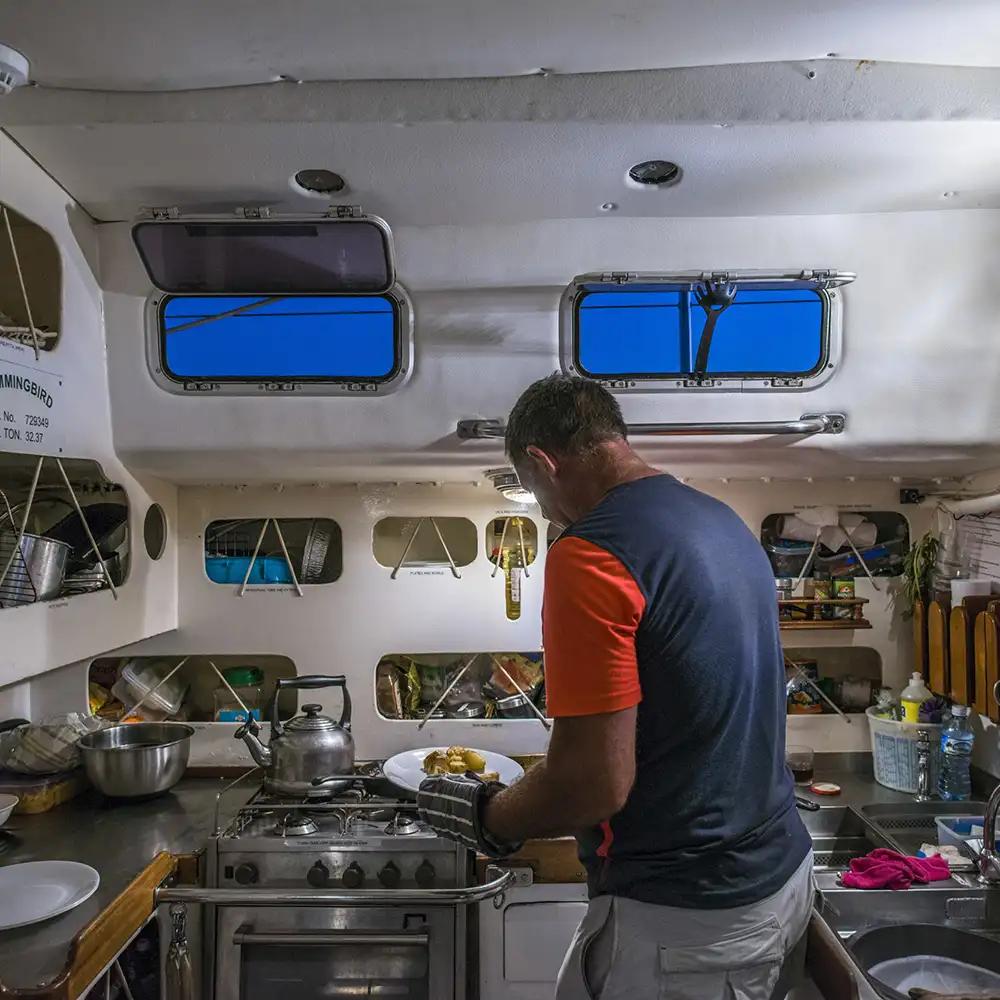
Leisure Time and Bonding with Crew
Relaxation: During off-watch periods, crew members have time to relax. This can include reading, listening to music, or simply enjoying the ocean’s vastness. It’s an excellent time for personal reflection and relaxation, away from the sailing responsibilities.
Learning and Skill Sharing:
- Crossing the Atlantic is a great time to learn from experienced sailors. Instruction and learning are central to every Rubicon 3 voyage, so while you cross the Atlantic, you will pick up seamanship, navigation, sail trim, and more skills from some of the most experienced sailors.
Enjoying Wildlife and Scenery:
- The Atlantic Ocean is home to various wildlife, and spotting dolphins, whales, or seabirds is a common and thrilling experience. Sunrises and sunsets at sea also provide spectacular views, making these times of day particularly special.
5. Recreational Activities:
- Depending on the weather and sea conditions, crew members can also participate in fishing, playing musical instruments, or even swimming mid-ocean if the wind is light and we have calm waters.
Is a bigger boat better for crossing the Atlantic?
Heading offshore is a different level of adventure from coastal sailing. Yachts that may be perfect for a season cruising in the Mediterranean can be inversely suitable for crossing an ocean and ocean sailing. Any yacht will happily make the crossing in the right conditions, so long it has enough wind and enough fuel to motor when the wind dies. Things change when the wind and sea state builds. That big square-shaped plastic fantastic, with all the room and space inside, will now be slamming, rolling, and wildly uncomfortable.
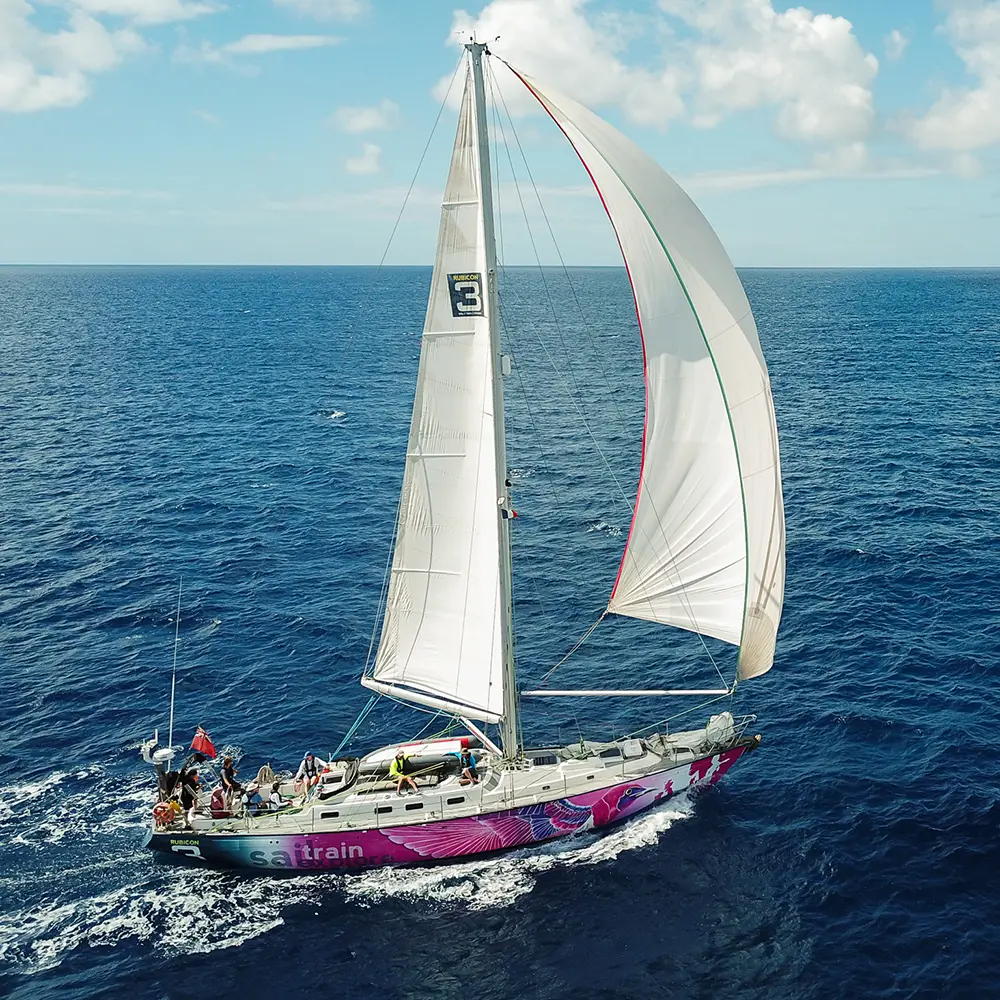
A yacht designed for maximum space is the opposite of what makes an excellent blue-water, ocean-going yacht. Compare a Beneteau or Jeanneau to one of Rubicon 3’s Clipper 60s; you will immediately know which is the right boat on which to make the crossing. Properly shaped hulls make for a far safer and more comfortable sail with a gentle entry and exit and buoyant overhangs that soak up the impacts. Cockpits are narrower to reduce water intake, and cabins have handholds and no wide open spaces, meaning crew are safe and secure below. So yes, of course, you can make a transatlantic crossing in a standard cruising yacht, and many do each year. However, if and when it gets mucky out there, and you’re facing genuine bad weather, you will be delighted if you are in a bigger, more robust, purpose-designed yacht.
The Safety Equipment Needed
You will find that properly equipped, commercially coded Cat 0 yachts such as those operated by Rubicon 3, have a comprehensive array of safety gear that most leisure or cruising yachts will not have.
- Life Raft: A certified, appropriately sized life raft for the crew, stored in an easily accessible location. Commercially operated Cat 0 yachts will carry 2-3 ocean-spec life rafts with Hydrostatic Release Units.
- Personal Flotation Devices (PFDs): Enough high-quality life jackets for each crew member, equipped with lights, whistles, spray hoods, and Personal Locator Beacons (PLBs)
- Harnesses and Tethers: Safety harnesses and tethers for each crew member to wear while on deck, especially in rough weather or at night.
- EPIRB (Emergency Position-Indicating Radio Beacon): An EPIRB is crucial for signalling your location in case of an emergency and should be attached by an HRU
- Satellite Phone or SSB Radio: Once you’re out of VHF range (about 30 miles offshore), you rely on the sat comms or SSB radio if you need weather or help.
- Radar: Essential for sailing into fog and seeing squalls at night.
- Enhanced First Aid Kit: An ocean-spec first aid kit will be far beyond an everyday yachting kit and require the crew to receive specific, more advanced medical training.
- Flares and Visual Distress Signals: Various flares (handheld, parachute, smoke) and other visual distress signals.
- Fire Extinguishers: Adequately sized and rated fire extinguishers strategically placed around the vessel.
- Bilge Pumps: Both manual and electric bilge pumps in case of water ingress.
- Emergency Steering: A backup tiller or emergency steering system in case of main steering failure.
- Emergency Rations and Water: Extra provisions include non-perishable food and potable water in case of extended rescue times.
- Drogue or Sea Anchor: To stabilize the boat in heavy weather conditions.
- Tool Kit and Repair Materials: Basic tools and materials for emergency repairs, including spare parts for essential equipment.
- Survival Suits: In cold weather sailing, survival suits can be life-saving in case of immersion. Rubicon 3 yachts are equipped with Fladen suits.
- Fog Horn and Bell: For signaling in low visibility conditions.
- Grab Bag: A waterproof bag containing essential items like a handheld VHF, spare batteries, first aid supplies, emergency food and water, and personal documents.
- Lifelines and Jacklines: Installed on deck to provide secure movement around the yacht.
- Thermal Protective Aids: In case of hypothermia risk during cold weather sailing.
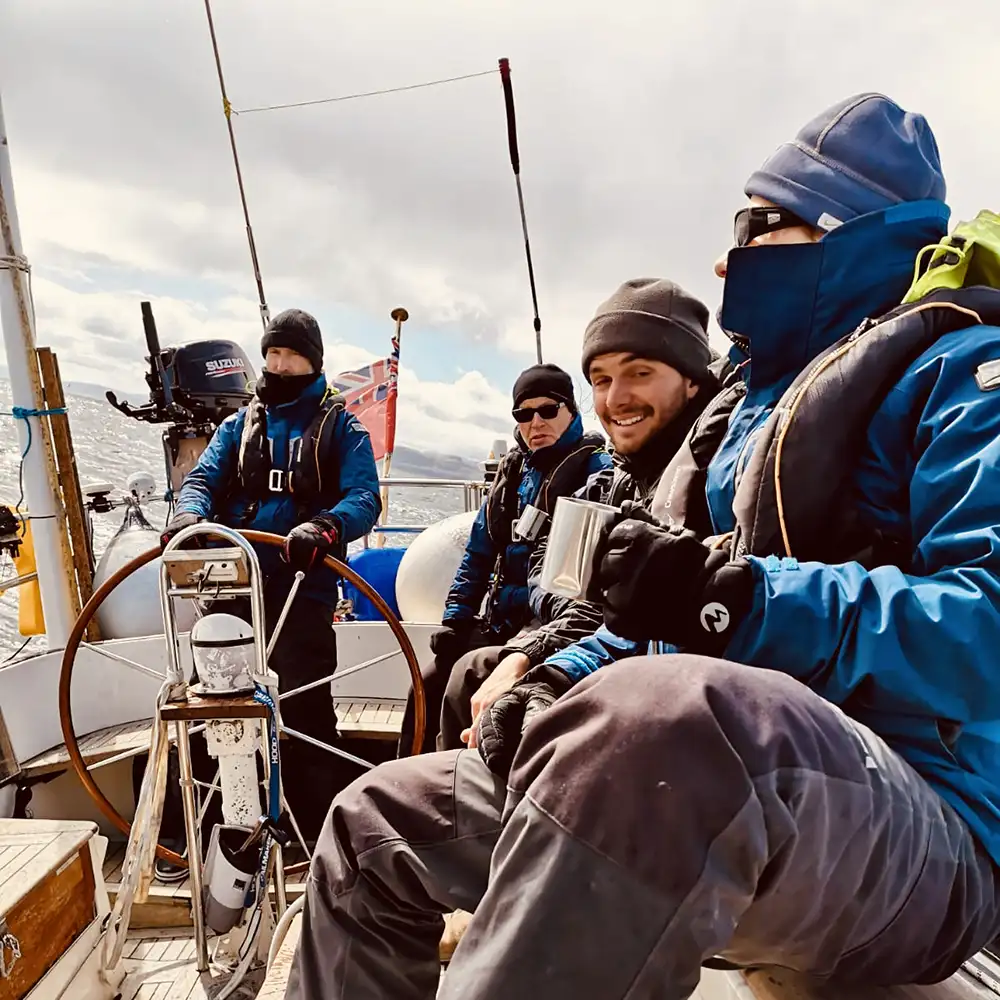
How experienced do you need to be to sail across the Atlantic Ocean?
Sailing across the Atlantic Ocean is a significant undertaking that requires a high level of experience and skill, particularly if you plan to do it independently rather than with Rubicon 3. Here’s a breakdown of the level of expertise typically needed:
- Sailing Skills: You should be proficient in sailing skills, including boat handling and understanding wind and weather patterns. Experience in offshore sailing, not just coastal cruising, is crucial because the ocean environment is demanding and much less forgiving.
- Ocean Navigation: Knowledge of ocean navigation is essential. This includes understanding how to use navigational and routing charts.
- Understanding Weather Patterns: A deep understanding of weather patterns is essential, including how to read and interpret weather forecasts and satellite data. You need to be able to make informed decisions based on changing weather conditions.
- Safety Skills: Safety is critical. This includes knowing how to keep the vessel and crew safe and using the various equipment, including emergency procedures and first aid.
- Mechanical Skills: Basic mechanical skills to deal with potential equipment failures are essential. This includes understanding the boat’s engine and electrical systems and how to perform minor repairs.
- Physical and Mental Stamina: Sailing across the Atlantic is physically and mentally demanding. You should be in sensible physical condition and mentally prepared for the challenges of a long voyage.
- Crew Management: If you’re sailing with a crew, experience in crew management and good communication skills are essential for a safe and harmonious journey.
- Previous Experience: You should have completed several shorter offshore passages before attempting an Atlantic crossing. This experience helps in understanding the demands of long-distance sailing and in preparing for the unique challenges of an ocean crossing.
Suppose you’re new to sailing or have limited experience. In that case, you must first gain experience by joining a crewed voyage with a company like Rubicon 3 or enrolling in advanced sailing courses focusing on offshore sailing. Additionally, many sailors choose to sail with experienced skippers or mentors for their first transatlantic voyage to learn and gain confidence.

How Long Does It Take To Sail Across the Atlantic
The time it takes to sail across the Atlantic Ocean can vary widely depending on which of the transatlantic routes are taken, the type of vessel, and the prevailing weather. Here’s a general idea:
- Route: The most common routes for crossing the Atlantic are the northern route (from the East Coast of the U.S. to Europe) and the southern route (from Europe to the Caribbean). The distance and weather on each route can significantly impact the duration of the trip.
- Type of Sailboat: The speed of a sailboat can significantly influence the duration of the journey. If the weather is good, faster, more modern sailboats can make the passage faster than older or heavier boats. If the weather is nasty, the modern lighter boats can struggle.
- Sailing vs. Motor sailing: Most boats will rely on a combination of sailing and using the engine (motor sailing), which can affect the total time. Fuel capacity will limit this, but large, long-lasting wind holes can necessitate some motor sailing unless you have a lot of spare time.
On average, here are some typical durations for the transatlantic journey:
- Northern Route (U.S. to Europe): Approximately 3-6 weeks, depending on the starting and ending points.
- Southern Route (Europe to the Caribbean): Generally takes 2-4 weeks, as this route often benefits from more consistent trade winds.
To give you an idea of comparison, a cruise ship would only take 6-8 days, while a traditional tall ship would be in the 3-6 week category depending on weather.
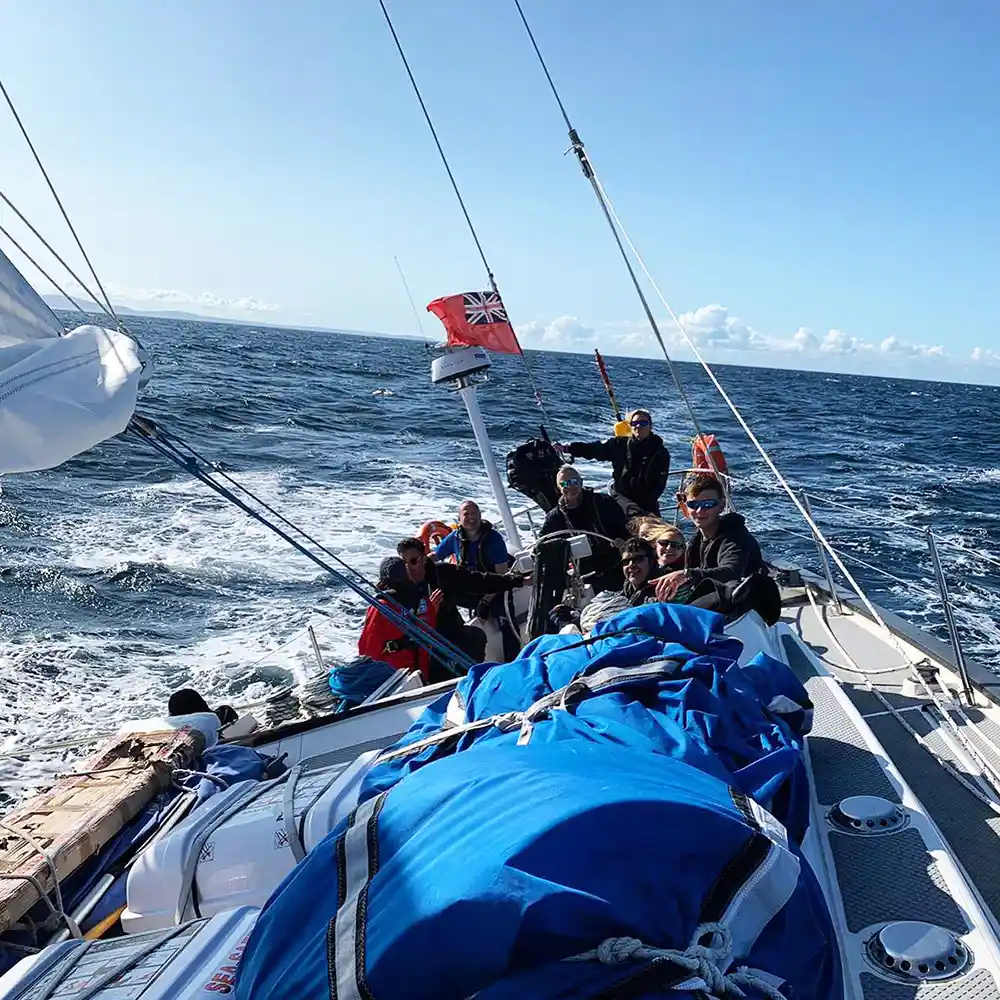
Want to sail across the Atlantic?
This article is there to guide you on what to look out for, what to expect, what makes the right boat and the various routes to take. A sail across the Atlantic is more than long-distance cruising – it is a serious undertaking and should not be taken lightly. If you are taking your boat, train and prepare like never before. If you are sailing with someone else, do your due diligence, and don’t let availability or convenience cloud your judgment. There have been too many tragedies caused by poorly prepared boats and sailors. We’re biased, obviously, but we genuinely believe that led by our professional crew, there is no better, safer, or more involved way where you will learn so much as a sail across the Atlantic with Rubicon 3.